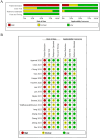Prenatal ultrasound scoring in diagnosis and postpartum outcomes prediction for Placenta Accreta Spectrum (PAS): a systematic review
- PMID: 39709346
- PMCID: PMC11662791
- DOI: 10.1186/s12884-024-07076-9
Prenatal ultrasound scoring in diagnosis and postpartum outcomes prediction for Placenta Accreta Spectrum (PAS): a systematic review
Abstract
Background: Placenta accreta spectrum (PAS) is one of the most dangerous pregnancy-related conditions. This study aims to conduct a systematic review of current research on the ultrasound scoring systems used in PAS patients with a comprehensive summarization of researches and comparison of prenatal ultrasound scoring in evaluating postpartum outcomes.
Methods: This systematic review was conducted and reported following the Preferred Reporting Items for Systematic Reviews and Meta-Analyses (PRISMA) guidelines. Studies were retrieved from four databases (PubMed, Cochrane Library, Embase and Web of Science) up to December 2023. Original studies involving women diagnosed with PAS using ultrasound scoring for diagnosis or outcome evaluation were screened based on predefined inclusion and exclusion criteria. The primary outcome was the diagnostic performance of ultrasound scoring systems and their effectiveness in predicting labor outcomes. The Quality Assessment of Diagnostic Accuracy Studies-2 (QUADAS-2) tool was utilized to assess the study quality. The study has been registered on the PROSPERO website with the registration number CRD42024507311.
Results: Sixteen studies met the inclusion criteria. 3930 patients were included in the review, with 1693 participants in the control group. Included studies had a high risk of bias in patient selection, with a low risk in flow and timing and reference standards. Existing studies have reported several indicators that can be included in ultrasound scoring systems and tested their effectiveness in diagnosis and severity evaluation. The pool sensitivity, specificity, and area under the curve (AUC) of ultrasound scoring system in diagnosing PAS were 0.89 (95% confidence interval [CI]: 0.82-0.94), 0.85(95%CI: 0.80-0.90) and 0.93 (95%CI:0.91-0.95). Ultrasound scores are associated with PAS outcomes including intraoperative haemorrhage, postpartum haemorrhage, hysterectomy, length of hospital stay, and neonatal prognosis. Limitation is that the existing studies are wide-ranging but have low replication and association.
Conclusion: Ultrasound scoring systems play a role in the prenatal diagnosis, management, and prediction of postnatal complications in PAS. Nevertheless, additional research is required to further evaluate the performance between different scoring systems to develop a unified consensus.
Keywords: Diagnosis; Placenta Accreta Index; Placenta accreta spectrum; Postpartum complication; Ultrasound scoring.
© 2024. The Author(s).
Conflict of interest statement
Declarations. Ethics approval and consent to participate: This study is a systemic review, which is known as one of the secondary research. It does not involve human participants, so it does not need the approval of the ethics body. Consent for publication: Not applicable. Competing interests: The authors declare no competing interests.
Figures




Similar articles
-
Clinical-sonographic scores for the screening of placenta accreta spectrum: a systematic review and meta-analysis.Am J Obstet Gynecol MFM. 2024 Aug;6(8):101369. doi: 10.1016/j.ajogmf.2024.101369. Epub 2024 Apr 16. Am J Obstet Gynecol MFM. 2024. PMID: 38636601
-
Ultrasound scoring system for prenatal diagnosis of placenta accreta spectrum.BMC Pregnancy Childbirth. 2023 Aug 7;23(1):569. doi: 10.1186/s12884-023-05886-x. BMC Pregnancy Childbirth. 2023. PMID: 37550654 Free PMC article.
-
Quantifying placenta accreta spectrum severity and its associated blood loss: a novel transvaginal ultrasound scoring system.Am J Obstet Gynecol MFM. 2024 Oct;6(10):101451. doi: 10.1016/j.ajogmf.2024.101451. Epub 2024 Aug 5. Am J Obstet Gynecol MFM. 2024. PMID: 39096965
-
Development and validation of MRI-based scoring models for predicting placental invasiveness in high-risk women for placenta accreta spectrum.Eur Radiol. 2024 Feb;34(2):957-969. doi: 10.1007/s00330-023-10058-8. Epub 2023 Aug 17. Eur Radiol. 2024. PMID: 37589907
-
Three-dimensional volume rendering ultrasound for assessing placenta accreta spectrum severity and discriminating it from simple scar dehiscence.Am J Obstet Gynecol MFM. 2024 Apr;6(4):101321. doi: 10.1016/j.ajogmf.2024.101321. Epub 2024 Mar 7. Am J Obstet Gynecol MFM. 2024. PMID: 38460827
References
-
- Silver RM, Branch DW. Placenta accreta spectrum. N Engl J Med. 2018;378(16):1529–36. 10.1056/NEJMcp1709324. - PubMed
-
- Irving FC, Hertig A. A study of placenta acreta. 1937.
-
- Jauniaux E, Ayres-De-Campos D, Langhoff-Roos J, Fox KA, Collins S. FIGO classification for the clinical diagnosis of placenta accreta spectrum disorders. Int J Gynaecol Obstet. 2019;146(1):20–4. 10.1002/ijgo.12761. - PubMed
-
- Liu X, Wang Y, Wu Y, Zeng J, Yuan X, Tong C, Qi H. What we know about placenta accreta spectrum (PAS). Eur J Obstet Gynecol Reprod Biol. 2021;259:81–9. 10.1016/j.ejogrb.2021.02.001. - PubMed
Publication types
MeSH terms
Grants and funding
LinkOut - more resources
Full Text Sources
Miscellaneous

